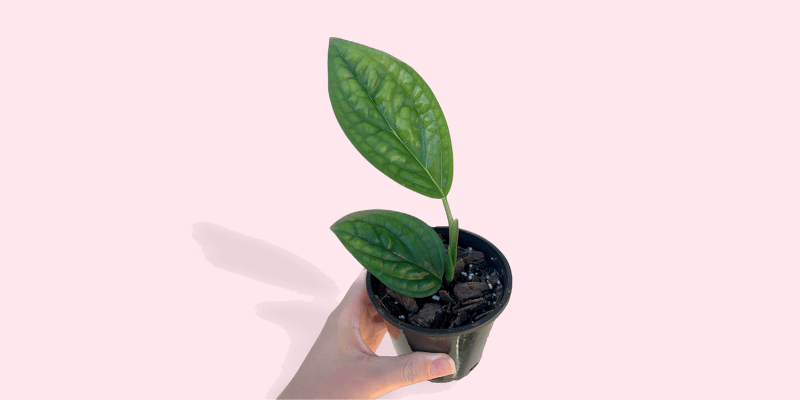Today we’re covering Monstera Peru, a hardy plant that’s perfect for beginner indoor gardeners.
These guys are eye-catching vining plants that look elegant twined around a moss pole or trailing from a hanging planter. They’re an ideal low-maintenance addition to any houseplant collection.
In this article, I’ll cover why Monstera Peru is a rare plant unlike other monsteras, how to give it ideal growing conditions, the best propagation method, and how to treat the common issues which come up.
Bonus: It purifies the air!
Table of Contents
Monstera Peru Care Guide
History, habitat, and characteristics
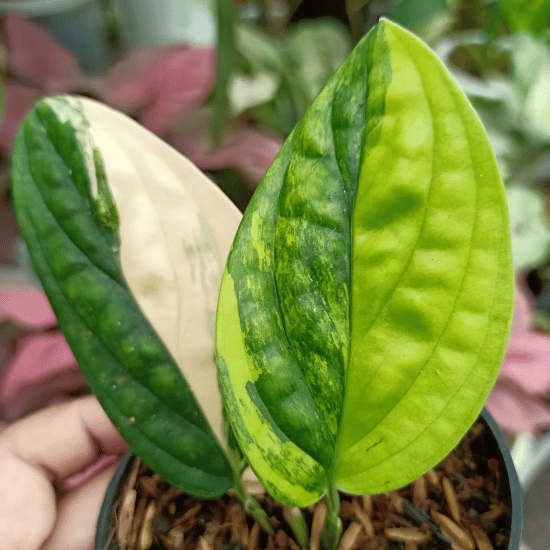
Monstera Karstenianum, commonly referred to as Monstera Peru and Green Galaxy monstera, is an aroid from the Araceae family that resembles a monstera but functions like a succulent. Its stiff, lance-shaped leaves feel leathery and feature deep glossy green veins. As this gorgeous plant matures, the veins grow even darker and form more pronounced puckers and ridges (something to look forward to!)
There’s some confusion over Monstera Peru’s place of origin, real name, and even its status as a monstera. Monstera is Latin for “monstrous” or “abnormal,” but in my opinion, the only thing abnormal about this beauty is just how arresting it is.
The second part of its name came from a rumor that the plant is native to Peru and nurseries often claim its origin is Venezuela or Thailand. In any case, it’s from the subtropical/tropical jungle environments of South and Central America, where there is a massive concentration of the Amazon rainforest.
As of now, there doesn’t appear to be any scientific classification of the plant. It’s sold as an entirely different species in Europe, the Epipremnum pinnatum Marble Planet. The lack of official classification may explain why the Monstera Peru doesn’t fenestrate, or grow holes, as most other monstera varieties do (I’m looking at you, Monstera deliciosa).
Monstera Peru is a hemiepiphyte, which means it’s a vining plant that can climb and trail on trees and other plants, but still has shallow roots in the soil for added support – the best of both worlds. Compared to other monstera, this guy grows slowly, with leaves that can reach up to half a foot long.
The plant itself can grow up to 12 feet tall outdoors! Indoors, it usually reaches 6 to 8 feet. If you want to encourage this vertical growth you’ll want to use a moss pole or stake to help it climb more quickly and produce larger leaves.
Although it’s rare, Perus sometimes appear with green and white variegation caused by a spontaneous chimeric mutation, which is a cellular mutation of the plant.
Let’s go over the best lighting, soil, temperature, and humidity conditions for Monstera Peru.
Light
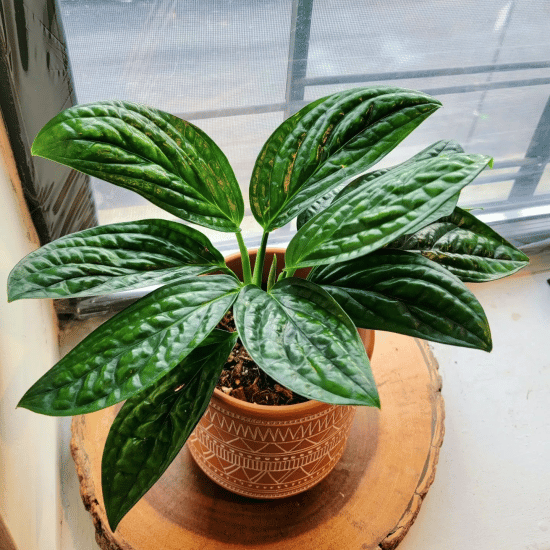
Like many indoor plants, Monstera Peru likes bright indirect light and won’t do well in direct sunlight, which can scorch its leaves. This makes sense since it mimics the bright light of its natural habitat, which is filtered by the jungle canopy.
Since the Peru is a darker green than many other monstera plants, it produces more chlorophyll, a green pigment, naturally through photosynthesis. Quick refresher: photosynthesis occurs when plants use sunlight to make food from water and carbon dioxide. The more chlorophyll a plant makes, the greener it will be. This is why the Monstera Peru doesn’t need as much light as others in the monstera genus.
Keep in mind that while the monstera plant can theoretically handle lower light, it will still thrive best in bright indirect sunlight, so placing it in a dark space will stunt its growth. An east or north-facing window is ideal for the type of light this tropical plant needs.
Water
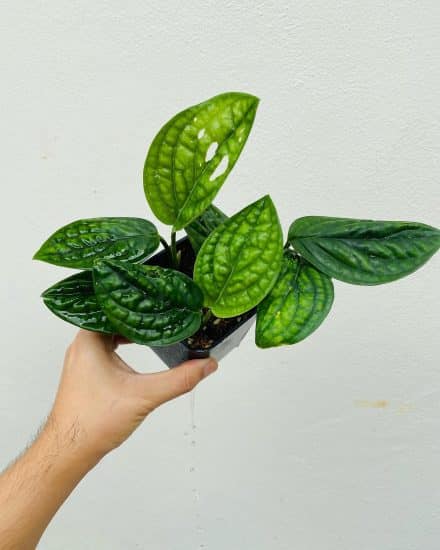
Remember how I mentioned Monstera Peru looks like a monstera but functions like a succulent? Its thick leaves can store water, which means it needs to be watered less than other Monsteras do, only about twice a week during its active growth period in spring and summer. In winter, when its growth slows, it will need water about once every two weeks.
How do you know when your Monstera Peru plant needs water? Simple – check to see if there is wet soil two or three inches into the pot. If it’s dry, it’s time to get out the watering can.
When you water Monstera Peru, give it a thorough soak and make sure it’s in a pot that has a large enough drainage hole. Like other drought-tolerant species, it can go without watering for some time, but when its roots sit in excess water, they can rot.
Temperature and humidity
As a tropical plant, Monstera Peru flourishes in warm temperatures of 65 to 80 degrees Fahrenheit. It isn’t tolerant of frost, which means sudden temperature fluctuations could shock and seriously damage it. Keep it away from drafty windows or air vents and it should be fine.
This plant craves 50% to 80% humidity levels. In winter, dry air and radiator heat can make moisture evaporate from the soil and heat stress the Monstera Peru plant. Don’t panic – there are easy ways to add extra humidity to its environment without sacrificing your own comfort. Try the following:
- Place it on top of a tray filled with pebbles and water
- Locate it next to a humidifier
- Mist it once every few days
- Group it with other plants so they each contribute to the local humidity (this is called transpiration)
Soil and planting
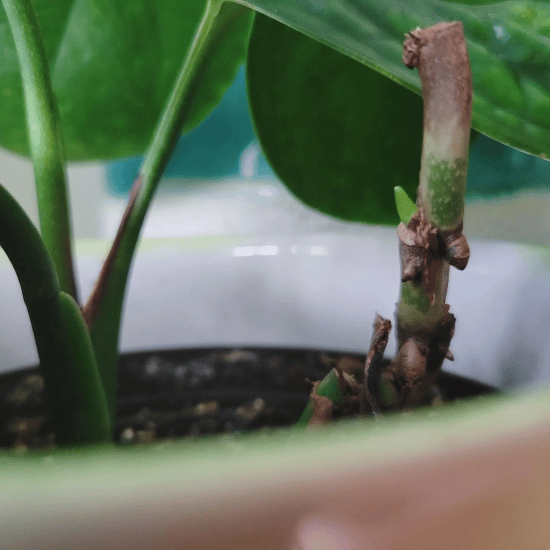
The Monstera Peru thrives in rich, moist, well-draining soil. Since it has shallow roots, they won’t tunnel too deeply into the soil, so you need a mix with the ideal combination of moisture retention and drainage. I recommend:
- 70% orchid bark
- 15% sphagnum moss (remember to always wear gloves when handling to avoid a slim chance of contracting a rare fungus)
- 15% perlite
If you don’t have this exact combination or ratio, that’s totally fine – the point is to create a soil mixture that drains well and doesn’t compact the root system of your plant, so it can breathe. You can also use any combination of:
- coco coir (natural fiber of coconut husks that retain water)
- compost or mulch
- pumice or perlite (extra aeration and drainage)
- shredded bark
- worm castings (extra nutrients)
The Monstera Peru will need repotting around every two years, or when you see roots emerging from the pot’s drainage holes. Any longer than this and it may become rootbound, which blocks it from imbibing nutrients and water from the soil. It will also need regular trimming since it grows quickly.
Fertilizer
The Monstera Peru plant likes regular fertilization every 3-4 weeks during spring and summer. Use a balanced fertilizer containing the Big 3 nutrients – nitrogen for leaf growth, and potassium and phosphorous for root and stem health. Bottle labels will display this combo as 5-5-5 or NPK.
Your Peru does not require any fertilizer when it goes dormant during the winter. Be careful not to overfertilize it, as this can burn its beautiful green leaves.
Now that you’re familiar with its ideal light, temperature, and soil conditions, let’s learn how to propagate the Monstera Peru and deal with pesky pests and common issues.
Monstera Peru Propagation guide
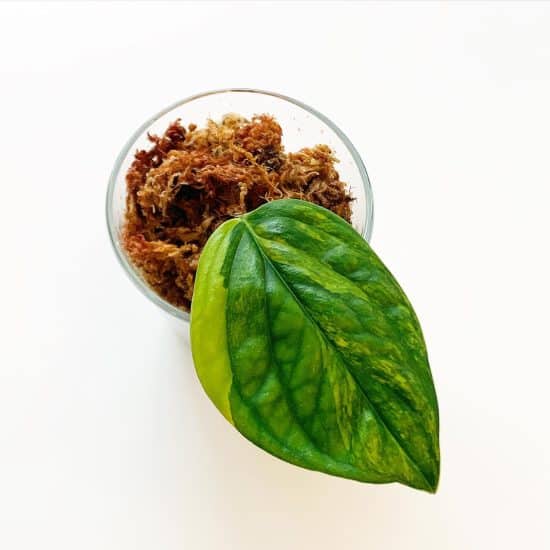
The best time to propagate Monstera Peru is in the spring and summer when it grows more quickly. You can use stem cuttings, sphagnum moss, LECA, or water propagation methods. We’ll cover using a stem cutting in soil, it’s easy and gives fast, reliable results. Moss propagation will be pretty similar.
To propagate your Monstera Peru in soil:
- Using sharp scissors or shears, cut a stem about eight inches long with several leaf nodes from a mature plant. Make sure to cut right below a leaf node, which is the little bump where leaves emerge from the stem.
- Remove any leaves on the bottom few inches of the cut stem.
- Leave the cutting in a warm location for a few days while the stem calluses over.
- Fill a pot with soil mixed with a little bit of fertilizer and plant the cutting four inches deep with the callus side down.
- Water regularly when the soil is dry two to three inches down. You’ll see roots in 3 or 4 weeks. The more ideal your cutting’s growing conditions, the faster it will grow.
Pro tip: If you do choose to propagate your plant in water use a clear plastic bag around the cutting to increase humidity levels until its roots begin to grow. Make sure it’s not airtight so that air can circulate.
Monstera Perus are low-maintenance plants, but if you notice yellowing leaves or unwanted insects, here’s how to deal with them.
Common issues
Brown leaf tips. Your plant needs more humidity. It’s native to tropical regions, after all, so don’t be afraid to get out the humidifier or the pebble tray.
Curling leaves. Your Monstera Peru isn’t getting enough water. Water it thoroughly so its drainage holes drip, then water again when the top 2-3 inches of soil is dry.
Yellow, dropping leaves. The plant is either overwatered or its soil isn’t draining properly. If you’re not watering too often, check for compacted soil and add a few handfuls of orchid bark or perlite to help it drain. You want soil moist but not soggy so the plant’s roots can breathe.
Leggy. Your plant isn’t getting enough sunlight, so it’s reaching toward the sun in a process known as etiolation.
Dust. The Monstera Peru’s large leaves can accumulate dust over time, which block its stomata, or tiny pores, from photosynthesizing. Clean it with a faucet, shower, or damp cloth (microfiber works well) to ensure its leaves can take in all the nutrients they need and retain their gloss. Bonus: A clean plant will also allow you to spy any encroaching pests earlier.
Speaking of pests, let’s learn how to keep them off your Monstera next.
Diseases and pests
Root rot. Your Monstera Peru’s roots are sitting in excess water. Make sure your soil mix and pot have adequate drainage (i.e., an airy substrate and a pot with large enough drainage holes).
Anthracnose. This is a fungus that can cause leaf tips to yellow, turn dark brown, and die. Pick off and throw away infected leaves, and stop misting your Monstera Peru until the problem is resolved. After picking off any leaves that are infected, you can use sprays of copper soap or Bacillus amyloliquefaciens, a plant growth-promoting rhizobacteria, to prevent future occurrences.
Spider mites, brown scale, mealybugs. Like most indoor plants, the Monstera Peru can attract its share of pests, although this usually happens when your plant is unhealthy for some reason. These critters eat the sap your plant needs to carry nutrients and water, interfering with the photosynthesis process.
How do you banish bugs without damaging your monstera? I prefer good old-fashioned water to insecticidal soap, as it’s better for the plant’s health. You can also put diluted isopropyl alcohol mixed with water on cotton swabs and thoroughly wipe under and over leaves and around stems.
If that isn’t doing the trick, try a half-diluted mix of Neem oil and water once a week until the pests are gone. I recommend applying whatever mixture you choose for at least one week after seeing the last bugs to prevent any larvae from hatching.
Conclusion
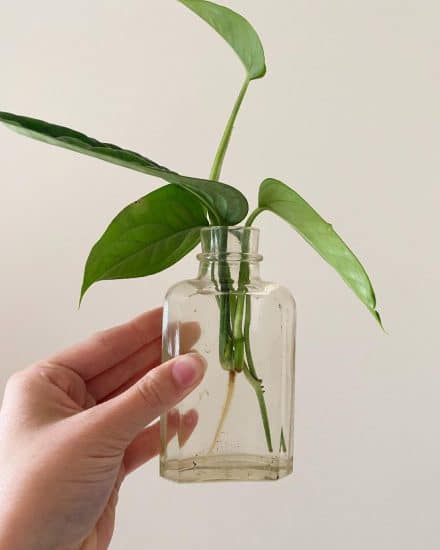
Monstera Peru is a fascinating monstera and succulent hybrid that grows darker, deeper textured veins as it matures. Keep it in bright indirect light with moderate to high temperature and humidity levels, and avoid direct sunlight. Make sure its planter has adequate drainage holes so your Monstera Peru isn’t sitting in an overly wet pot, and support it with a moss pole for maximum vining effect.
With the slow and steady growth rate of this emerald climber, you’ll be on your way to having an indoor jungle before you know it.
FAQ
Is Monstera Peru rare?
It used to be rare, but has recently become a popular indoor plant. You should be able to buy Monstera Peru at local nurseries or garden stores.
Does a Monstera Peru need a pole?
Monstera Karstenianum doesn’t strictly require a pole, but a moss pole or totem will enhance the plant’s growth rate and support it as it climbs.
Do Monstera Perus flower?
The Monstera Peru flower is rare to see inside, but in the wild it sprouts plain white blooms.
What is the difference between Monstera Peru and Monstera Siltepecana?
Monstera Peru looks a lot like other similar plants, namely Monstera siltepecana (Silver Monstera) and Monstera pinnatipartita (full care guide here), but don’t be fooled. Siltepecana has lighter-hued leaves with more of a silvery sheen than Monstera Peru. Its leaves also have a more pointed heart shape and less puckering.
As for Monstera pinnatipartita, when it’s young, it doesn’t have fenestrations or leaf splits, but the mature plant does, which definitively rules out Peru.

